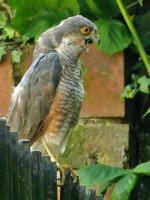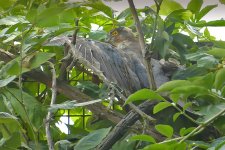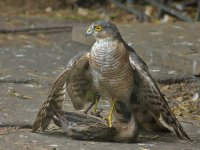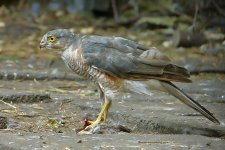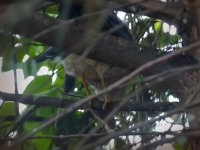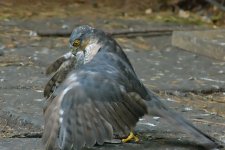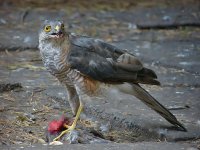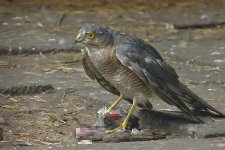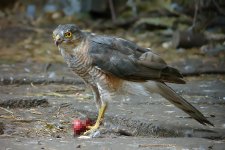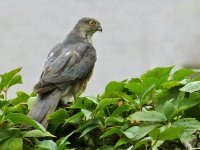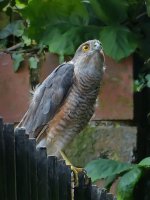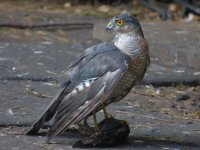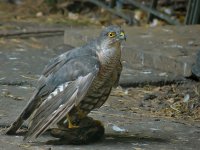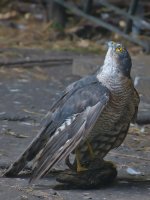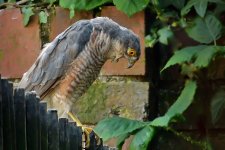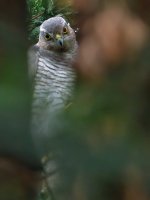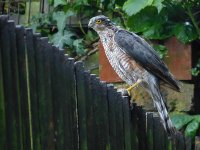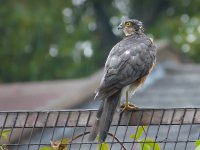ChrisKten
It's true, I quite like Pigeons
As some will know, I get regular visits from Sparrowhawks, and see new juves each year. It's just luck that nobody feeds the birds locally except for me, so there's always good numbers of potential prey in or near my garden. Incidentally, regular Sparrowhawk attacks does not have a detrimental effect on the bird population, at least not in my garden. I've large numbers of Sparrows and Starlings that breed nearby; both species had three broods this year. There's also plenty of Tits and Finches, Robins, Wrens, Dunnocks...etc. So all the local birds seem to prosper from the food, water, and cover (trees) I provide, including the Sparrowhawks.
ATM I've an adult male and a juvenile (probable male) visiting regularly; the adult male might be the same one that's been around for a few years, he disappears during the breeding season, maybe migrates. He's never been wary of me, and I can go into the garden without disturbing him when he's perched in my trees. I'm not yet sure this adult is him, but he's a Mouse specialist like the other one... so we'll see.
The first pic is of him perched on my fence, he'd just swooped into my trees, and then flew down to the fence. He's got a lot of worn (some very brown, Sun damaged?) feathers and is moulting, so he looks a mess. He's not calling, but choking on a feather; he expelled it successfully. I'd say it's a safe bet to assume he'd recently eaten, so I thought he's just digest his meal where he felt safe.
The second picture was taken about five minutes later, when he realised that one of the Starlings had only made it to the bush as he swooped into my trees. It took him a couple of minutes, but there was nowhere for the Starling to go, and the mantling (wings and tail spread to cover the prey) stopped it getting past the Sparrowhawk.
The third picture was taken as the Sparrowhawk took the Starling to the ground; notice the same mantling technique as in the bush, used for the same reason (limiting escape options), and probably to hide the prey from other predators. I've blurred the Starling's head, as some people are a bit squeamish
The fourth picture was taken over twenty minutes later, and there's mostly the body left, nothing but bones left of the head and neck. Not all Sparrowhawks eat the same way, some seem to prefer to eat the breast first, others the neck; some like what's inside the head Oh, while he was eating, one of the Mice ran from under the fence to try to get a monkey nut; it wasn't just me that saw him either, and I figured the Sparrowhawk would make a mental note of that behaviour for another time.
Oh, while he was eating, one of the Mice ran from under the fence to try to get a monkey nut; it wasn't just me that saw him either, and I figured the Sparrowhawk would make a mental note of that behaviour for another time.
I'd taken 100s of pictures, and there wasn't any Squirrels about to interact with the Sparrowhawk, so I left him to finish his meal. I did hear the Pigeons spook a few times, so I'd guess he moved into my trees a bit later. The Pigeons don't notice a feeding Sparrowhawk at first, as they feel safe in my garden, but as soon as the Sparrowhawk spreads it's wings... they panic
When I looked up into my trees about twenty minutes later, I saw the Sparrowhawk had moved to my trees to finish his meal. Thirty minutes later and he was still there, but he wasn't eating the Starling, that was well gone... he was now eating a Mouse. No light and too many obstructions, but I'm hoping you can make out the tail in the last picture.
So, this Sparrowhawk has probably had three meals by 2pm... I'd guess that's a good day for him
(All pics taken through double glazing, and in poor light)
ATM I've an adult male and a juvenile (probable male) visiting regularly; the adult male might be the same one that's been around for a few years, he disappears during the breeding season, maybe migrates. He's never been wary of me, and I can go into the garden without disturbing him when he's perched in my trees. I'm not yet sure this adult is him, but he's a Mouse specialist like the other one... so we'll see.
The first pic is of him perched on my fence, he'd just swooped into my trees, and then flew down to the fence. He's got a lot of worn (some very brown, Sun damaged?) feathers and is moulting, so he looks a mess. He's not calling, but choking on a feather; he expelled it successfully. I'd say it's a safe bet to assume he'd recently eaten, so I thought he's just digest his meal where he felt safe.
The second picture was taken about five minutes later, when he realised that one of the Starlings had only made it to the bush as he swooped into my trees. It took him a couple of minutes, but there was nowhere for the Starling to go, and the mantling (wings and tail spread to cover the prey) stopped it getting past the Sparrowhawk.
The third picture was taken as the Sparrowhawk took the Starling to the ground; notice the same mantling technique as in the bush, used for the same reason (limiting escape options), and probably to hide the prey from other predators. I've blurred the Starling's head, as some people are a bit squeamish
The fourth picture was taken over twenty minutes later, and there's mostly the body left, nothing but bones left of the head and neck. Not all Sparrowhawks eat the same way, some seem to prefer to eat the breast first, others the neck; some like what's inside the head
I'd taken 100s of pictures, and there wasn't any Squirrels about to interact with the Sparrowhawk, so I left him to finish his meal. I did hear the Pigeons spook a few times, so I'd guess he moved into my trees a bit later. The Pigeons don't notice a feeding Sparrowhawk at first, as they feel safe in my garden, but as soon as the Sparrowhawk spreads it's wings... they panic
When I looked up into my trees about twenty minutes later, I saw the Sparrowhawk had moved to my trees to finish his meal. Thirty minutes later and he was still there, but he wasn't eating the Starling, that was well gone... he was now eating a Mouse. No light and too many obstructions, but I'm hoping you can make out the tail in the last picture.
So, this Sparrowhawk has probably had three meals by 2pm... I'd guess that's a good day for him
(All pics taken through double glazing, and in poor light)




